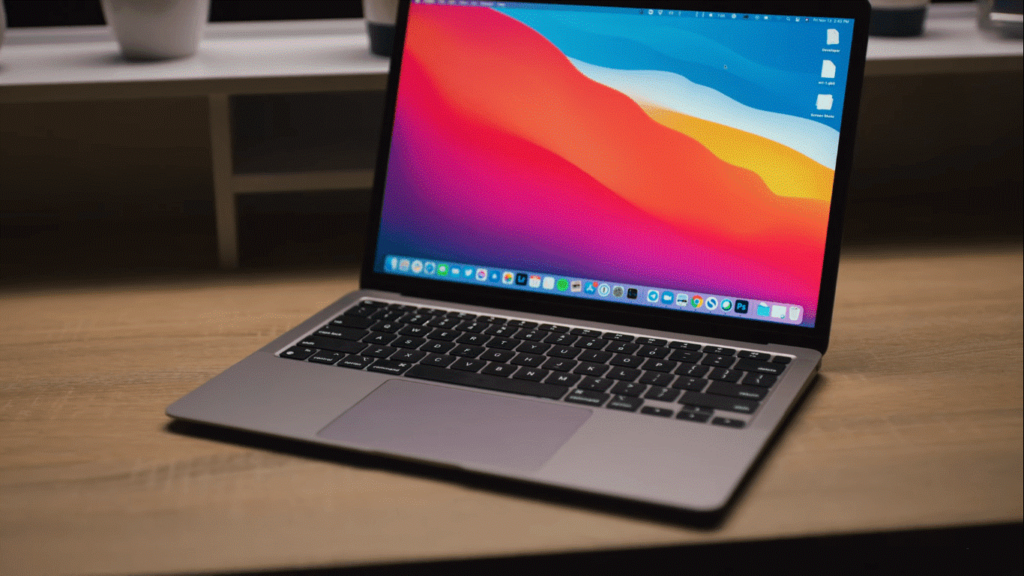
“It’s fair to say that using the G5 processor in a portable device as thin and light as the Powerbook is incredibly difficult.” That’s what David Moody, vice president of Mac hardware marketing said when Apple failed to use its own G5 processors in its mobile devices in 2005, and replaced it with Intel processors that were more advanced at the time.
Now, after fifteen years of using Intel processors in Mac computers, Apple has taken a bold step by ditching the last weird component of its hardware and using its own M1 chip that everyone has been waiting for since 2018. In fact, the new chip exceeded all expectations, and made the The new MacBook is a revolutionary device in every sense of the word, as if Intel has been holding back the progress of Macs all those years.
New MacBook Design
MacBooks with the M1 processor have a very familiar design, the design is the only aspect that has not changed any noticeable, and in fact it is not a big deal, the design of MacBook devices is one of the most elegant designs among portable devices. On the other hand, Apple has promised users a revolutionary new device that will redefine their MacBooks, so getting a device with a design that looks exactly like the older version is a bit disappointing.
MacBook with M1 processor
MacBook Air combines luxurious design and high build quality, compact size and light weight just as its name suggests, with a length of 30.5 cm, width of 21.1 cm, thickness of 1.6 cm and a weight of only 1.29 kg. The 13-inch screen comes with the same thick edges as the previous one, and it was possible to reduce the size of the two devices more while maintaining the same screen size if the company went towards reducing the edges more.
The new M1 chip made it possible to remove the cooling fan completely, which means that the temperature of the internal components of the device remains within its normal limits even while it is working without the need to cool it, so the MacBook Air works as silently as any other iPad.
On the other hand, the MacBook Pro has an almost identical design with some minor external differences such as the screen size and the Touch Bar, while internally, the device has kept the cooling fan, which we will talk about more in the performance section.
MacBook with M1 processor
Keyboard and touchpad
The company has replaced the Butterfly keyboard that all users previously complained about with the Magic Keyboard on the new MacBooks, which offers a better typing experience, and is supposed to avoid all the technical problems and glitches that appeared in the Butterfly keyboard that hampered the user experience. The keyboard of the MacBook Pro has a Touch Bar on the top, unlike the Mac Boom Air that it’s missing, and while this might be fine for some users who don’t like the idea of a touch bar, some find it a useful addition.
MacBook with M1 processor
The touchpad remains the same, which can confidently be described as the best touchpad in a mobile device with its very large area and perfect responsiveness. Despite the good experience provided by the touch panel and keyboard, they cannot be considered a new addition to the device, as they are not exclusive to the new version. If you are using a MacBook for the first time or you are using an older version of it, you will feel the difference immediately.
M1 . processing chip
The M1 chip is an improvement over the A-series processors that Apple uses in its iPhones, but it’s designed in a completely different way. M1 is not only a processor or central processing unit, but rather a complete processing chip capable of doing all processing operations, including graphics processing, and RAM is also built into it. The M1 chip was built with the 5nm technology that Apple used to build the A14 processor in the iPhone 12. On the other hand, Intel used 10nm technology to build its latest 11-generation processors, and does not intend to use the 7nm technology until 2022.
The M1 chip has eight processing cores, compared to 6 in Intel’s most powerful mobile processors. 4 of them are dedicated to high performance and complex operations that require large processing power, while the remaining 4 cores are dedicated to performing simpler tasks to ensure greater energy savings.
The chip also has 8 cores dedicated to graphics processing, a 16-core neural processing unit to perform artificial intelligence and image processing tasks, an integrated unit to control storage and data flow to and from SSD storage, and many other controllers and sensors.
MacBook performance with M1 processor
Before going into details and exact numbers, I will simplify the matter for those who are not specialists or interested in technical matters. Apple uses its new M1 processor in its new Macs. The processor delivers faster performance and greater energy efficiency than previous Intel processors when working in conjunction with Apple software and hardware, allowing Apple to control all internal components to achieve complete harmony between components, operating system, CPU, graphics and battery.
Apple was very self-confident when introducing the MacBooks with the M1 processor and very proud of what they had come to. According to her, the new M1 chip is faster than the Intel processor that it previously used in its devices. According to her statements, the overall performance of the MacBook Air is 3.5 times faster than before, the graphics processing is five times faster, and the processing speed of artificial intelligence-based processes in the MacBook Pro is 11 times faster.